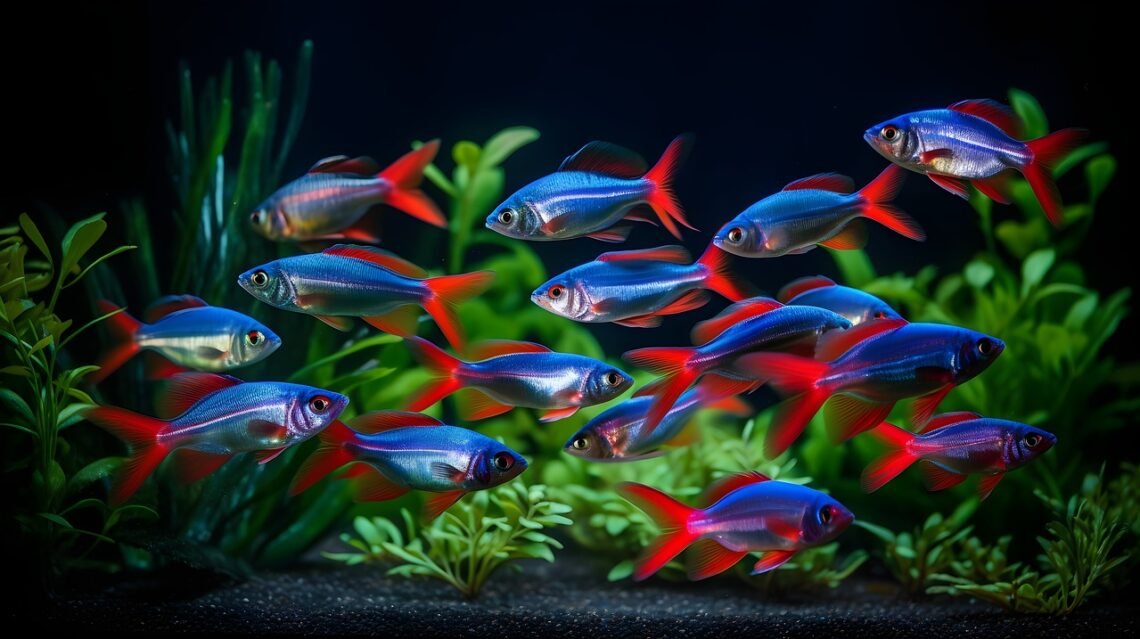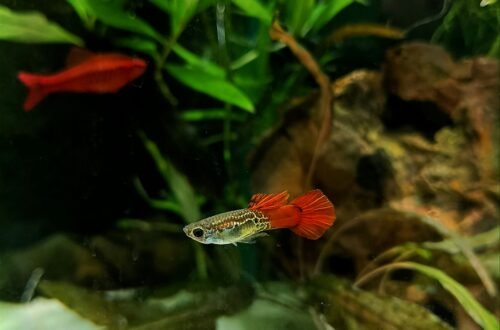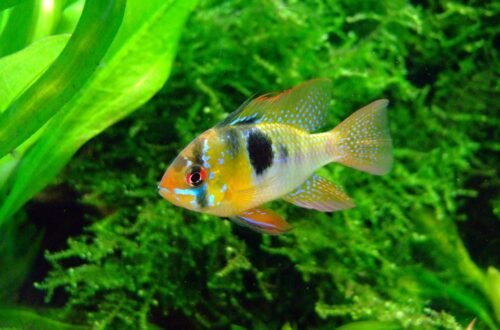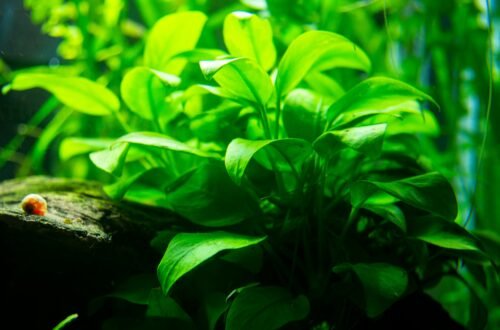When setting up a freshwater aquarium, choosing the right fish and plants is crucial for creating a thriving underwater environment. Whether you’re a seasoned aquarist or just starting, selecting compatible species ensures a balanced, visually appealing, and low-maintenance aquarium.
Understanding Freshwater Aquariums
A freshwater aquarium is an enclosed, artificial ecosystem designed to house fish, plants, and other aquatic life. These aquariums mimic natural freshwater environments like rivers, lakes, and streams. When creating a freshwater aquarium, consider factors such as tank size, water quality, and maintenance needs. A well-planned setup will support both the fish and plants, ensuring a harmonious and healthy environment.
Best Freshwater Aquarium Fish
Choosing the right fish for your aquarium is essential for maintaining a balanced ecosystem. Below are some of the best freshwater aquarium fish that are easy to care for and popular among aquarists.
Livebearers
Guppies: These vibrant, small fish are known for their lively nature and colorful tails. Guppies are hardy and adaptable, making them ideal for beginners.
Mollies: Mollies are versatile fish that can adapt to a variety of water conditions. They come in different colors and sizes, and their peaceful nature makes them compatible with many other species.
Platies: Platies are another great option for beginners. They are small, colorful, and thrive in community tanks.
Swordtails: Named for their sword-like tails, these fish are active and can add a unique aesthetic to your aquarium. They are easy to care for and breed readily in captivity.
Tetras
Neon Tetras: Known for their striking blue and red coloration, Neon Tetras are small, peaceful fish that do well in schools. They are sensitive to water conditions, so regular maintenance is key.
Cardinal Tetras: Similar to Neon Tetras but slightly larger and more vibrant, Cardinal Tetras are a beautiful addition to any tank.
Black Skirt Tetras: These fish have a distinctive black coloration and are hardy, making them a great choice for community tanks.
Cichlids
Angelfish: With their elegant fins and distinctive shape, Angelfish are a popular choice for larger tanks. They can be territorial, so ensure they have enough space.
Dwarf Cichlids: These smaller cichlids are less aggressive and more suitable for community tanks. They come in various colors and patterns, adding diversity to your aquarium.
Catfish
Corydoras: Corydoras catfish are small, bottom-dwelling fish that are excellent at cleaning up leftover food. They are peaceful and enjoy being in groups.
Plecos: Plecostomus, or Plecos, are algae-eaters that help keep the tank clean. They can grow quite large, so make sure your tank is big enough to accommodate them.
Gouramis
Dwarf Gouramis: These small, brightly colored fish are known for their labyrinth organ, which allows them to breathe air. They are peaceful and do well in community tanks.
Pearl Gouramis: With their unique pearlescent appearance, Pearl Gouramis are a beautiful addition to any tank. They are relatively easy to care for and have a calm temperament.
Betta Fish
Betta fish, also known as Siamese fighting fish, are famous for their vibrant colors and flowing fins. They are territorial and should be kept alone or with compatible species in a well-planted tank. Betta fish require specific care, including warm water and a well-filtered tank, to thrive.
Goldfish
Goldfish are a classic choice for freshwater aquariums. They come in various varieties, including fancy goldfish with unique body shapes and colors. Goldfish require more space and produce more waste than other species, so they need a larger tank with efficient filtration.
Best Freshwater Aquarium Plants
Incorporating live plants in your aquarium not only enhances its beauty but also promotes a healthier environment for your fish. Here are some of the best freshwater aquarium plants to consider:
Foreground Plants
Dwarf Baby Tears: These tiny, bright green plants form a carpet at the bottom of the tank, providing a lush look. They require high light and CO2 levels to thrive.
Java Moss: Java Moss is versatile and easy to care for, making it ideal for beginners. It can attach to rocks, driftwood, or simply float in the tank.
Midground Plants
Anubias: Anubias plants are hardy and can tolerate low light conditions. They grow slowly and can be attached to decorations, making them a popular choice.
Cryptocoryne: Crypts are low-maintenance plants that come in various colors and sizes. They are perfect for adding texture to the midground of your tank.
Background Plants
Amazon Sword: Amazon Swords are tall, leafy plants that provide excellent background coverage. They require moderate light and nutrient-rich substrate to grow well.
Vallisneria: Vallisneria, also known as eelgrass, has long, ribbon-like leaves that create a flowing effect in the water. It’s easy to grow and can quickly fill up the background space.
Floating Plants
Duckweed: Duckweed is a small, fast-growing floating plant that helps reduce light penetration, controlling algae growth. It also provides shelter for fish.
Water Lettuce: Water Lettuce has larger, rosette-shaped leaves that float on the surface. It’s beneficial for reducing nitrate levels in the water.
Creating a Balanced Aquarium Ecosystem
To create a thriving aquarium, it’s essential to balance the fish and plants. Fish produce waste that plants can use as nutrients, while plants help oxygenate the water and absorb harmful toxins. Ensuring that your chosen fish and plants are compatible is crucial.
For example, some fish may nibble on plants, so selecting hardy species or plants that can tolerate such behavior is advisable.
Maintaining Water Quality
Water quality is vital for the health of your aquarium. Regular water changes help remove toxins and replenish essential minerals. Monitoring pH levels, temperature, and ammonia levels is crucial to prevent stress on your fish and plants. Using filters and aerators can help maintain oxygen levels and keep the water clean.
Feeding Your Aquarium Fish
Proper nutrition is key to keeping your fish healthy and vibrant. There are various types of fish food available, including flakes, pellets, and live food. It’s important to feed your fish the right type and amount of food, as overfeeding can lead to water quality issues. Research the dietary needs of your specific fish species to ensure they are getting the nutrients they need.
Aquarium Lighting and Its Impact
Lighting plays a significant role in the growth of aquarium plants. Plants need light for photosynthesis, which is vital for their growth and the overall health of the tank. However, too much light can promote algae growth, so it’s important to find a balance. Choose lighting that suits the needs of your plants and maintain a consistent light cycle to mimic natural conditions.
Common Freshwater Aquarium Challenges
Maintaining a freshwater aquarium comes with its challenges. Algae growth can become problematic if not controlled. Regular maintenance, including cleaning the tank and managing light exposure, can help prevent this issue. Fish diseases and plant decay are other common problems that can arise. Quarantining new fish before introducing them to the main tank and maintaining good water quality can help minimize these risks.
Aquarium Decorations and Aesthetics
Decorating your aquarium can enhance its visual appeal and provide enrichment for your fish. Choose decorations that complement your fish and plants, such as rocks, driftwood, and caves. The substrate you choose also plays a role in plant growth and fish behavior. Sand and gravel are popular choices that can influence the overall aesthetic of the tank.
Aquascaping Tips for Freshwater Aquariums
Aquascaping involves designing the layout of your aquarium to create a visually pleasing environment. When aquascaping, consider the placement of plants, rocks, and decorations to create depth and balance. Mixing different plant species with varying heights and textures can create a natural and cohesive look. Aim for a layout that not only looks good but also provides shelter and hiding spots for your fish.
The Importance of Regular Maintenance
Regular maintenance is crucial for the long-term health of your aquarium. This includes cleaning the tank, trimming plants, and checking equipment to ensure everything is functioning properly. Establishing a maintenance schedule can help you stay organized and ensure that your aquarium remains a healthy environment for its inhabitants.
Safety Tips for Freshwater Aquariums
When maintaining your aquarium, safety should always be a priority. Handle equipment carefully to avoid accidents and ensure that all electrical components are properly installed. Prevent contamination by washing your hands before and after handling fish or plants and using separate tools for different tanks if you have more than one. When introducing new fish or plants, acclimate them slowly to avoid shock and reduce the risk of disease transmission.
How to Choose the Right Aquarium for Beginners
If you’re new to the hobby, starting with beginner-friendly fish and plants is a smart choice. Hardy species like guppies, platies, and Java Moss are more forgiving of beginner mistakes. Start with a smaller tank, as it’s easier to manage, but ensure it’s large enough to provide a stable environment. Take your time to learn about the specific needs of your chosen species and avoid overcrowding the tank.
Setting up a freshwater aquarium can be a rewarding experience. By choosing the right fish and plants, you can create a beautiful and thriving underwater world. Remember to focus on compatibility, maintain good water quality, and provide proper care to your aquatic pets and plants. With a little effort and knowledge, your freshwater aquarium will not only be a stunning addition to your space but also a healthy environment for its inhabitants.
FAQs
What are the easiest freshwater fish to care for?
Guppies, Platies, and Neon Tetras are among the easiest freshwater fish to care for, making them ideal for beginners.
How often should I change the water in my freshwater aquarium?
It’s recommended to change about 25% of the water every two weeks to maintain good water quality and reduce the buildup of toxins.
Can I keep live plants with all types of freshwater fish?
Most freshwater fish can coexist with live plants, but some species, like goldfish, may nibble on them. Choose hardy plants that can withstand this behavior.
What’s the best way to control algae in my aquarium?
To control algae, regulate light exposure, perform regular water changes, and consider adding algae-eating fish like Plecos or Amano Shrimp.
How do I introduce new fish to my aquarium safely?
To introduce new fish safely, acclimate them slowly by floating the bag in the tank for 15-20 minutes and gradually adding small amounts of tank water to the bag before releasing the fish.






